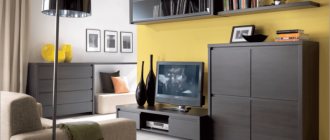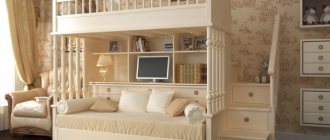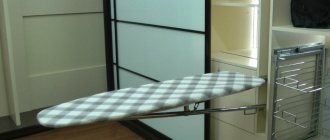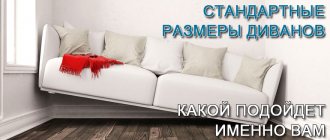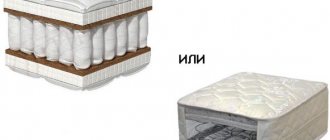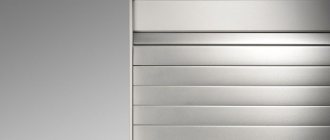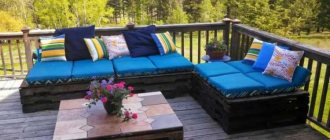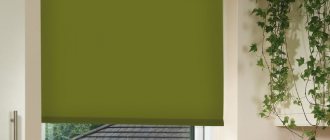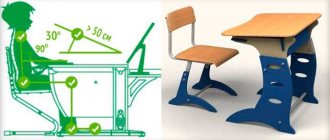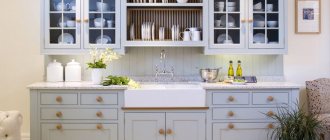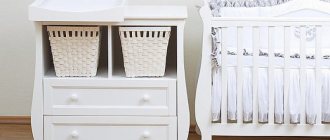Gluing the shield in the usual way
The quality of glued furniture panels primarily depends on the preparation of the workpieces. The wood selected is dry, smooth and without knots, for example, beech. You can buy ready-made timber and pass it through a thicknesser to get blanks of the same thickness.
The appearance of the glued shield matters, so the blanks are laid out by color. After this, the growth rings are marked with chalk and the arrangement of the blanks is changed so that they alternate in direction. If the growth rings are in the same direction, then when the tree dries, it will bend in one direction. When alternating the direction of the growth rings, there will be no bending.
Tree ring arrangement
Lines are drawn with chalk on the unfolded structure, which are then used when assembling the shield after adjustment.
Shield with chalk mark
Due to the uneven sides, gaps remain between the plots. To remove them, the boards are folded sideways and jointed on a machine.
Preparing boards for jointing
After jointing, check the tightness of fit of the workpieces to each other. If not all defects are removed, then jointing is repeated.
The plots matched to each other according to the marks are placed in a shield and prepared for gluing.
Assembling a shield from fitted boards
The blanks are glued together with PVA glue. It is applied to the end of the board from a special bottle, and then smoothed over the surface with a soft rubber roller.
Applying glue to workpieces
The blanks, coated with glue, are assembled into a shield and then compressed with four clamps: two from below, and two from above. The clamps must not be pinched, otherwise the shield will be pushed to one side.
Compressing the shield with clamps
Clamps are also installed at the joints of the workpieces.
Clamps at the joints of workpieces
After 2 hours, the clamps are removed, and the remaining glue is removed with a shoe knife. The prepared surface is sanded with a soft float and sandpaper size 100-180.
Sanding furniture panels
After sanding, the furniture board is used for its intended purpose.
An example taken from the YouTube channel of Vladimir Zhilenko , video “How to make a furniture board. How to make a wood board”
Shelf supports
There are a huge number of types of shelf supports. However, they can be divided into two groups: shelf holders for chipboards and shelf holders for glass. In turn, each of these groups can be divided into two types: shelf holders with and without fixation.
The shelf holder for chipboard consists of 2 parts: a rod and a shelf holder.
Fig. 14.
The screw is installed in the cabinet wall, and the shelf holder is installed in the body of the shelf. To install the shelf holder, you need to drill holes in the shelf and cabinet wall. For most shelf supports, the hole sizes are standardized; they are shown in the figure below. However, when installing the shelf support, you should carefully read the instructions to avoid errors.
Fig. 15.
It should be noted that shelf holders for chipboard come with or without fixation. The shelf holder with fixation has an eccentric mechanism, thanks to which the shelf will be firmly connected to the cabinet wall. Shelf supports with fixation have one more advantage; shelf supports of this type serve as additional reinforcement of the furniture structure.
Fig. 16.
Glass shelf holders have a simpler design. They are attached only to the cabinet walls using a self-tapping screw.
Fig. 17.
Shelf holders for glass without fixation are a rod or an angle. Shelf holders with fixation have a special screw with which the glass is firmly fixed and cannot accidentally fall out. Fig. 19.
Screed for table tops. Provides a reliable connection between two parts of countertops. To increase the accuracy of joining parts, it is advisable to use it together with a dowel. For a standard screed, non-through holes with a diameter of 35 mm and a depth of 19 mm are made in the connected parts of the tabletops. The distance between the holes should be 15 mm less than the length of the tie. The groove width must be at least 7 mm.
To tie two tabletops together, use a pair of ties. To install the tie rods, it is necessary to make recesses for the tie rod stops and a slot for the screw. This can be done in various ways. The most affordable option is the following. The recess for the stops is made with a Forstner drill of a suitable diameter; the slot for the screw can be made using a jigsaw.
Fig.20.
Gluing a shield from blanks connected by slats
If you glue a board from planed boards, then difficulties will arise:
- workpieces clamped with a clamp can “spread apart” and you get a step;
- the step can only be removed with a thicknesser or long-term grinding.
These disadvantages do not exist when connecting the panel parts to an inserted rail. For work, choose the following order:
1. Prepare 40 mm boards. They should be smooth and of the same thickness.
2. Lay out a shield from the boards and draw the base with a pencil. The base mark is needed to make cuts on the desired side and to correctly assemble the boards into a board.
Base mark on the shield
3. On each workpiece, cuts with a depth of 9 mm are made on both sides with a circular saw. The blanks placed along the edges of the shield have one cut made.
Workpieces with grooves
4. Slats are cut from wood scraps, which are 1 mm thinner than the width of the cut, and 1 mm less wide than the depth of the cuts in two boards, that is, 17 mm. The rail inserted into the groove should move easily.
Shield slats
5. For gluing, use PVA glue. It is applied with a brush so that it fills the grooves.
6. The assembled shield is clamped with clamps and left to dry.
7. The squeezed-out glue residues are removed with a sharp tool, and then the shield is sanded. This method of joining workpieces requires minimal surface grinding.
Glued board on slats
An example taken from the YouTube channel Wooden Ware , video “Gluing wooden panels, quickly and efficiently!”
Confirmat
The most common type of fastener is confirmat. At the same time the easiest to use. With its help, assembling furniture is easier and faster than using other types of furniture screed. Especially if during assembly you have to drill holes for fasteners yourself. Using a confirmat, two parts are connected at an angle of 90 degrees.
Fig.1.
In order to tighten the two parts, you need to drill two holes. One in one part, with a diameter equal to the diameter of the confirmator head, the other, at the end of the second part, with a smaller diameter equal to the diameter of the threaded part.
As a rule, drills with a diameter of 6 and 5 mm are used for this, respectively. However, there is a combination drill available for drilling holes at the same time. It is very comfortable. There is no need to constantly rearrange drill bits or use two drills at the same time.
Fig.2.
Confirmat is a universal fastener, but it has some disadvantages and application features.
Confirmat should be used simultaneously with the use of dowels. A dowel is a wooden rod with a diameter of 6-8 mm and a length of 20-30 mm (in the photo below, next to the confirmation). The dowel acts as a guide and does not allow parts to move during tightening.
Fig.3.
Despite the fact that furniture assembled using confiramate can be assembled or disassembled, furniture made from laminated chipboard does not tolerate this very well. As a rule, after one disassembly, the furniture screed no longer holds well.
The confirmation should be wrapped carefully. The best option is by hand or with a screwdriver at low speed. Otherwise, the confirmation thread turns into a drill, which breaks the hole.
Fig.4.
In order to recess the head into the body of the furniture part, you should use a wrench and do it carefully, otherwise there is a possibility of the thread breaking. Sometimes it is necessary to pre-calculate.
Con fasteners. Those. Unlike other types of fasteners, it remains visible, so it is necessary to use special plugs or stickers to hide the fasteners.
Fig.5.
Fig.6.
Gluing a shield without clamps
In order for the board plots to stick together well, they must be compressed. To do this, it is not necessary to have clamps; you can use simple wedges.
In this case, the boards are fastened with dowels. This is a connecting wooden element in the form of a cylinder with chamfers at the ends. You can buy such connectors at a hardware store or make them yourself.
For the shield, smooth planed boards are prepared. They are laid out on a flat surface and a sign of the order of display is applied with a pencil.
Marking the order of boards in the shield
A special device is used to mark places for dowels on the boards. They are applied at different levels.
Marking places for dowels
Places for dowels are transferred to the end of the workpieces.
Marking places for dowels at the end of the workpieces
To drill a hole for the dowel, use a jig. This is a device that is rigidly attached to the board and has a guide for the drill.
The hole is drilled with an M8 drill. The drilling depth is marked on it with electrical tape.
Drilling a hole for a dowel
The shield is glued on two stands made to the size of the shield.
Shield stands
The end of each workpiece is coated with PVA glue. It is important to fill the dowel holes with glue.
Dowels are driven into the holes, and then the blanks are knocked into a shield.
Knocking down blanks into a shield
The assembled shield is placed on stands. To prevent the shield from bending, a weight is placed on top, and to prevent it from sticking to the stand, insulation from newspaper is laid.
Laying the shield on stands
The shield is clamped on the stand with four jambs. They are hammered in until glue appears at the joints of the plots.
Shooting joints on a stand
After drying, remove any remaining glue with a sharp object, and then sand the surface.
Sanding the glued board
An example taken from the YouTube channel Mikhail Deryvedmid , video “How to make a furniture panel without clamps and clamps”
How to make through tenon joints
1 Pull and glue the parts together, draw an auxiliary line. Using a brush drill bit with a stopper at a depth of 4.3 cm, drill tenon holes in one piece that extend into the adjacent piece. Place the holes at a distance of 7.5-10 cm from each other.
2 Apply wood glue to 1 1/2-inch grooved tenons then insert the tenons into the holes. Using a punch, drive the spikes in until they stop.
3 Cover the tenon holes with hardwood plugs coated with glue. Let the glue dry, then sand the surface with an emery block.
Recently, corner joints of slab materials with a miter bevel have become increasingly popular in the manufacture of furniture. In this article, our friend and colleague Sergei Novikov will share the secrets of making such a non-standard joint. Unlike a joint with an acute angle, which, firstly, is quite traumatic, and secondly, is itself susceptible to chipping and deformation with minimal impact, this option is free from the above-mentioned disadvantages.
So, first, using a tire, we file the mating edges at an angle of 45 degrees. In principle, this can be done on a sawing machine, but a plunge-cut saw with a guide bar (2 passes) in relation to chipboard gives better results.
So, we get two parts with sharp corners, let's move on directly to connecting them.
To enhance the strength of the joint, we will need a lamellar router (I think that we can get by with a regular one, but with special devices (for now there are only vague outlines in our heads). These flat furniture dowels (lamellas) are inserted into the grooves selected by the lamellar.
They prevent the parts from moving during displacement, and also add strength to the final connection, significantly increasing the gluing surface.
We coat the mating surfaces with glue (any PVA-containing glue will do).
We connect the parts and clamp them with clamps until the glue dries completely. After removing the clamps, glue drips remain on the corner - they do not need to be removed, because... Later they will fall off on their own.
The next step is to smooth the corner. It is carried out either with an angular cutter (45 degrees) or with a cylindrical cutter, but for this the router must have an angular base.
After cutting the corner, you get this trapezoidal profile. Now our task is to improve this corner. You can, of course, just paint it or stick an edge on it, but the edge will not stick, and when painting you won’t be able to get a neat, flat surface.
The cut must be puttied. In this case, automotive putty with fiberglass is used (what was on hand), but it is better to use more homogeneous mixtures.
Degrease the surface to be putty. The solution for this should not contain water. Apply the composition with a spatula, rubbing it into the pores and leveling.
After final drying, we finally smooth the surface with a sanding block with fine sandpaper. Now let's paint it over. Cheap spray paint will work for this.
To protect the surface of the edge of the cut, we glue it with masking tape and cover it with paint 2-3 times. For additional durability and shine, we open it with a layer of acrylic varnish.
Site search:
Before the creation of modern technologies and fittings, furniture was made by carpenters. Lock joints, tenons, dowels, wedges were used as fasteners for connecting panels together; the same “fittings” were used in the construction of wooden houses, etc.
Glue was used to make the joints rigid; naturally, there was no talk of any ideal precision in the joints. Only a virtuoso, using tools such as a saw and a chisel, could more or less accurately maintain the dimensions.
Nowadays, such connections of parts are specifically used to give furniture an “antique” style. This article describes the main fasteners and fittings that are used in, which are used in, etc.
This type of fastening is rarely used independently; it is used only to provide rigidity in conjunction with eccentric couplers.
Its main function is to prevent the panels from moving relative to each other and giving additional rigidity to the fastening. Used in conjunction with an eccentric coupler. It is made from hard natural wood and has a cylindrical shape. This is a very simple and cheap part that has been used in wooden joints since time immemorial.
Screw tie
A screw tie consists of a screw and a barrel; they are used to secure the end of one panel to the face of another. For example: attaching a shelf to a side panel.
This is a very strong fastening due to the large tightening stroke. The only drawback of this fastener is that the screw head is visible from the front of the panel.
You can, of course, close them with special plugs, but this is also not a panacea. The plugs on the outer panel of the cabinet do not look aesthetically pleasing.
Installing this type of fastener requires skills; beginners may encounter such problems as aligning the holes of the barrel with the hole in the end of the shelf, and it is not so easy to pull out an unnecessary barrel from its nest.
But the inconvenience during assembly and aesthetic errors are more than compensated for by the reliability and durability of the connection. connections!
Conical coupler
Conical tie is often used for fastening thick chipboard panels (25 mm, 38 mm)
One of its advantages is the absence of visible caps on the front side of the panels. Unlike the screw in a screw tie, the rod used in a tapered tie is screwed into the panel. The tie itself has 2 holes, one for the rod, which is screwed into the panel layer, the second for the screw of the conical tie.
The disadvantage of this type of fastener is that the tightening stroke is not long; under heavy loads, the holes for the rod screw may become loose over time, and then the tie will simply stop working!
Furniture corner
Quite a simple type of fastener, easy to install. Does not require any additional holes in the panels for its installation. There are both metal and plastic options.
Quite a durable type of fastening and inexpensive in price. The disadvantages are that it is visible and does not look aesthetically pleasing, especially if it is made of plastic. But this is the main type of fastening in built-in furniture, since eccentrics and Euroscrews are used only for fastening chipboard shelves to each other.
Euroscrew
This fastener is often used for assembling kitchen furniture modules and in economy class furniture. Just like with a screw tie, Euroscrew heads or plugs are visible on the front side of the side panel of the cabinet.
It screws into the end of the shelf with a pre-drilled hole. This screed also belongs to the economy class. To install it, 2 holes are drilled - into the end of the shelf and into the face of the part. They are attached perpendicular to each other. The most commonly used euro screws are 7 mm in diameter and 50 or 70 mm in length.
This screed has 2 significant drawbacks:
Firstly, the outer side of the cabinet, if there are many shelves behind it, as a rule, is all “disfigured” with caps or Euroscrew plugs. Therefore, these fasteners are used in economy furniture; in kitchens, this drawback is hidden thanks to the cabinets standing in a row.
Secondly, furniture assembled with euroscrews cannot be disassembled and reassembled more than 3 times, since screwing the tie into the end of the shelf destroys its internal structure.
Eccentric coupler
One of the most popular types of fasteners today. All high-quality furniture is assembled on an eccentric screed (minifixes). Its operating principle is as follows: an eccentric rod is screwed into the face of the part to which the other panel will be attached at the end, into which, in turn, through the end of the other shelf it is screwed into the eccentric itself, then the eccentric turns the rod into itself.
An eccentric tie is always used in conjunction with a wooden dowel, which was described earlier. The dowel provides additional rigidity to the assembly and prevents the fastened panels from moving relative to each other.
Furniture assembled on this screed can be disassembled and assembled an unlimited number of times! There are different diameters of the eccentric itself: 25, 15, 12 mm.
Since the eccentric itself is visible on the side panel, plugs are provided for it to match the color of the panel. One of the disadvantages is the weakening of the coupler in case of spontaneous rotation of the eccentric.
To avoid this, some hardware manufacturers have provided notches directed in the opposite direction from its rotation during installation, which enhances adhesion.
Types of eccentric couplers
As practice shows, furniture is assembled and disassembled with great difficulty if all the fasteners in it are the metal tie described above. Let’s say that in order to remove one shelf, you practically need to dismantle half the cabinet.
For horizontal parts (shelves) it is more convenient to use “plastic” eccentrics. Their operating principle is the same as that of a metal eccentric coupler. The only difference is that the eccentric, located in the shelf, fits onto the rod screwed into the face of the sidewall from above and there is no need to disassemble half the cabinet for this. In some factories, this type of fastener is called a shelf holder, since it is intended only for horizontal parts. Horizontal shelves assembled using these ties further tighten the joint, which increases the rigidity of the entire furniture frame.
Here, the metal eccentric itself is located in a housing, most often in a plastic one. Repeated dismantling and installation of furniture does not lead to wear of the joints.
There is a wide variety of furniture fasteners on the furniture market, but the principle of operation is the same for all. Knowing the operating principle of one type of eccentric coupler, you can easily understand the others.
Making furniture from furniture board, wood and chipboard with your own hands is a great way to get something that meets all your expectations. Any piece of furniture made with your own hands will not only be exclusive, but also fit perfectly into the surrounding interior, because its color, shape, size will be whatever the creator of this furniture wants.
You can make a wide variety of furniture yourself from wooden panels - tables, cabinets, chests of drawers, beds, etc. The main thing is to carefully follow the sequence of the described actions and work as carefully as possible. Basic materials and tools used for making furniture from furniture panels:
· Wooden or chipboard furniture panels; · furniture varnish; · self-tapping screws; · electric drill with a set of drills; · chisel; · screwdriver; · grinder; · hacksaw for wood; · ruler and simple pencil; · various accessories: o handles for drawers and doors; o hinges for doors; o guides for sliding furniture elements, etc.
Make your own furniture from wood: we make a table from wood, chipboard or furniture board
The table is an indispensable part of the interior, so you want such an important item to be multifunctional, strong and serve for many years. Making the table yourself will provide confidence in its reliability and durability. Homemade furniture board can be an ideal material for such furniture. Today there are many variations of tables - computer, desk, kitchen, folding, etc. Let's try to analyze the manufacturing sequence of some of them in all details. Computer desk made of furniture board (wood or chipboard)
A computer desk will allow you to save precious centimeters of space and place all the components of your computer in convenient and easily accessible places. To make such a table you will need 8 furniture panels: three measuring 2000x600x18 mm, three measuring 2000x400x18 mm and two measuring 2000x200x18 mm. Additional materials and tools required for the manufacture of a computer desk: · edged board 12x120 mm; · dowels; · plywood sheet 6 mm thick. The process of making a computer desk.
Initially, a drawing of a computer desk made of wood or chipboard is developed and dimensions are calculated.
From one of the furniture panels (the largest size) we cut out the tabletop, side walls, bottom and top of the cabinet. The corners of the sides located in the upper front part can be trimmed and sanded. In that part of the sides that will be located close to the wall, it is necessary to cut a recess for the plinth measuring 5x5 mm.
To ensure the rigidity of the structure, in the middle of the side of the internal vertical wall we cut out a 200x20 mm recess for installing a transverse panel, which we make from a small panel. We fix all the finished parts with self-tapping screws.
We are making a place for the system unit. Don’t forget to round off dangerous corners and make recesses for the baseboard.
We hide the voids under the cabinet and space for the system unit with slats.
We make a frame for the shelves above the table and attach it to the assembled elements of the table.
A medium-sized sawn furniture board will serve as a blank for the top shelf, and a small board will serve as a middle partition attached to the tabletop.
Above the cabinet there will be a shelf with a lintel, which we make from the smallest furniture board. We install it in the right place.
It's time to make drawers - the walls are made of edged boards, and the bottom is made of plywood. We connect all the elements using self-tapping screws. We install guides for drawers and for a pull-out shelf-tabletop.
We cut out a table top for the keyboard from a 400 mm wide panel. We use the cuttings of the shields on the front elements of the boxes.
We disassemble the entire structure, process it with a sander and cover each of its components with a two-layer ball of varnish.
We allow the varnish to dry, complete the final assembly of the table, install the handles - and our computer desk is ready! Desk made of furniture board, wood or chipboard
A piece of furniture such as a desk is an indispensable element of a student’s office or room. There is always room for books, notebooks and work documents. To make such a table, you need three furniture panels of different widths - 200, 400 and 600 mm, as well as other basic materials and tools listed at the beginning of the article.
- sheet of plywood 6 mm thick;
- block 20x20 mm;
- square
The process of making a desk.
In general, the process of making a desk is practically no different from the process of making a computer desk. The only difference is that the desk is a more massive structure containing more drawers, shelves, and niches. First we make a drawing of the product and mark all the dimensions.
We make the tabletop from the largest panel - we cut it out, round the corners, fasten it, and reinforce it with bars.
We cut out pencil cases from medium-sized furniture board. The upper corners of the sides are rounded.
We cut out shelves measuring 400x350 mm, as well as doors for niches. Having cut out the blanks for the plinths, we complete the manufacture of the frame. Having cut two squares measuring 70x70 mm from plywood, cut them diagonally. The resulting triangles must be placed on the back side of the frame. We align the frame using a square and fix it with triangles.
The frame is ready.
We cut out and install the shelves at the distance corresponding to the drawing.
We install the guides.
We cut out the parts of the boxes and fasten them together.
We cut out and install the doors.
We disassemble our table into its component elements and, after carefully treating it with a sander, open it with two layers of varnish. We finally assemble the product. We fasten the tabletop with bolts. We install the shelves and plinth on corner holders. We mount the fittings, having previously made holes in the fastening areas.
All is ready.
Kitchen table made of furniture board, wood or chipboard
The kitchen table is one of the most necessary things in the house. Such a table can always be used in a small apartment, in a large house, or in a country house.
The basic materials and tools required to make a kitchen table from wood or chipboard are listed above. The size of the furniture board used should be 2000x600x18 mm. Additional materials and tools needed to make a desk:
- timber 40x40 mm;
- legs;
- socket nuts with a diameter of 12 mm;
- spanners.
The process of making a kitchen table.
We make a tabletop.
We add rigidity to the tabletop by reinforcing it with bars.
We prepare areas for the legs (drill holes, install fasteners). Attaching the legs
We sand the tabletop and seal it with varnish
Let the product dry and enjoy the result of your labor.
So, we have given examples of hand-made three versions of a table from furniture board. What other furniture can you make from furniture board, wood or chipboard with your own hands?
We make a cabinet from furniture panels (wood or chipboard)
A cabinet made from furniture board, the manufacturing process of which is described below, will fit perfectly into the interior of a nursery or hallway. All dimensions given in the description of the work can be adjusted at will.
The basic materials and tools that will definitely be needed to make any furniture from a panel have been described above. In this case, you will need 7 furniture panels: three with dimensions of 2000x600x18 mm, three with dimensions of 2000x400x18 mm and one with dimensions of 2000x200x18 mm.
Additional materials and tools needed to make the cabinet:
· hardboard sheet;
· plywood sheet 6 mm thick;
· rod for hangers;
· two bars for fastening the rod.
The process of making a cabinet.
We make the sides of the cabinet from panels, shortening the width of each by 70 mm, since the depth of the cabinet, according to the standard, should be 530 mm. In the lower corner of each sidewall it is also necessary to cut a 50x50 mm recess for the baseboard.
We make the bottom and top of the shelves for the drawers - leaving 775 mm width when sawing the board. The height of the boxes should be 200 mm, and the gap between them should be 20 mm.
The top of the cabinet should be slightly wider than the shelves for drawers - 800 mm.
Using self-tapping screws, we attach the bottom of the cabinet to the sides at a height of 50 mm above the floor, and the middle part at a height of 420 mm. We use a shield 400 mm wide as a shelf for hats; it must be fixed at a distance of 200 mm from the top. We fix the base using corner holders. The hardboard sheet will serve as the back wall of the cabinet. We carefully fasten everything together with self-tapping screws - and the frame is ready.
We fix the retractable mechanism for the drawers close to the sides, since the front sides of the drawers will overlap.
We cut out the drawer elements from plywood. During the sawing process, we make holes every 100 mm along the workpiece so that the plywood sheet does not crack during assembly. We assemble and insert the drawers into the closet. We make the front parts from the narrowest panel, but they will need to be attached only at the very end of assembling the cabinet.
We cut the doors out of a 400 mm wide panel and do fittings - the doors should cover the middle shelf. We cut off the corners on top of the doors and sand them with a machine until smooth transitions between the sides are formed. We drill three holes for hinges on each sash. We install hinges and fasten the doors.
We attach the bars with drilled holes for the rod to the sidewalls using self-tapping screws.
We disassemble the furniture and coat each component with two layers of varnish. Let the varnish dry well and assemble the cabinet.
We make holes for handles in drawers and doors. We install the facades, mount the handles, while connecting the plywood part of the drawers, located in front, and the front part, made of a panel. We check if everything is securely fastened. The cabinet is completely ready. It's interesting to know that your old closet can find a new life with...
Making a chest of drawers from a wooden or chipboard furniture panel
The chest of drawers is a universal piece of furniture. It is multifunctional and practical, so it will find a place in the nursery, in the hallway, and in the bedroom. To make a chest of drawers, the first thing you need to do is purchase a furniture panel measuring 2000 x 400 x 18 mm. Other basic materials and tools that will be required in the furniture making process are listed at the beginning of the article.
Additional materials and tools needed to make a chest of drawers:
- a sheet of plywood, the thickness of which is 6 mm;
- dowels.
The process of making a chest of drawers.
After developing the drawing and establishing the dimensions of all the necessary parts, we cut out the frame elements from the panels and fasten them with self-tapping screws. In the back wall we make a cut under the plinth measuring 50x50 mm.
For aesthetic reasons, the lid is attached to the frame not with screws, but with dowels.
Cut out the sides and ends of the drawers. The external elements are also cut out, but are not attached at this stage. We attach the retractable mechanisms for the drawers (you don’t have to buy them, but make them yourself), and check their functionality.
We disassemble the frame and polish each component. We open the elements of the chest of drawers with furniture varnish, after complete drying we reassemble the frame and insert the drawers.
We drill holes in the drawers and their loose external elements and fasten them with handles.
It turned out to be a great chest of drawers!
Making a hallway from wood, chipboard furniture panels
The hallway, the manufacturing process of which is described below, has a number of advantages:
- multifunctionality;
- aesthetic appeal;
- naturalness;
- the ability to help create order.
Before starting work, you need to prepare the basic material and tools, the list of which is given above. When making a hallway, you will need 10 furniture panels: seven measuring 1600x400x18 mm, three - 2000x400x18 mm.
Additional materials and tools required for making a hallway:
- seven edged boards 2000x120x16 mm;
- two tongue and groove boards 2000x240x18 mm;
- three-meter rail;
- six-millimeter sheet of plywood;
- dowels.
Hallway manufacturing process
We begin the work by making a cabinet 820x400x400 mm. To do this, we use one of the 1600 mm long shields on its components. Don't forget to make a groove for the baseboards. We connect all the manufactured parts with self-tapping screws, except for the bottom strip - we fasten it with dowels.
We cut out the door for the cabinet, install the fittings, and install the door.
We also make the retractable mechanism for the cabinet ourselves from strips of plywood 20 and 40 mm wide. After installing the mechanism, we check its operation.
We cut out the parts for the drawers and connect them with self-tapping screws, having previously drilled holes for them. We also cut out the fronts of the drawers, but do not install them until the product is fully assembled.
We attach the upper part of the cabinet with dowels.
We cut out the parts and assemble the second cabinet 820x500x400 mm. We manufacture and install doors.
A two-meter furniture board will serve as material for the pencil case. We cut out the constituent elements of the pencil case and fasten them together with self-tapping screws. Remember about the recesses for the baseboard.
“Plywood corners will help enhance the rigidity and reliability of the structure.
We outline the places where the shelves will be attached, and calculate the distance between the boards that we will screw to the rail.
We cut out and install the top shelf intended for storing hats. To install it, you will need leftovers from previous cuts.
We disassemble, sand and varnish the entire structure.
After the varnish has dried, we reassemble the hallway and fasten it to the wall with self-tapping screws. At the end we screw the handles. Product completed!
Making a bed from wood or chipboard furniture board
A wooden bed is what you need, because furniture board made from pine needles is an environmentally friendly material
. The design provides two spacious drawers and sides that prevent the child from falling.
Initially, we prepare the main material and tools, a list of which is given at the very beginning of the article. The main material is furniture board 2000x200x18 mm.
It is no coincidence that furniture fittings are distinguished by such a variety of types - this is determined by the many options for furniture designs. At the same time, special requirements are placed on it - it must not only have high reliability and provide rigidity, but also be invisible.
A description of all types of furniture fasteners would have a volume that would obviously go beyond the format of this article, so it makes sense to limit ourselves only to its main varieties, which are used for fastening furniture panels.
Do-it-yourself laminated chipboard additive
Adding or drilling parts also refers to the preparatory stage of assembling furniture with your own hands.
Through holes are drilled only for assembly with confirmations. It is better to use a special confirmation drill. You can do without it: drill from the front surface with an 8 mm thick drill, and from the end with a 5 mm drill. But in this case there will be no countersink for the confimat head. This means that “sinking” the fasteners neatly flush with the surface of the chipboard will be problematic.
For shelf holders, blind holes are drilled from the inside.
For guides, hinges, and lifting mechanisms, do not add laminated chipboard using a drill yourself; you just need to prick it with a self-tapping awl along the marking mark.
Chipboard connection at an angle of 45 degrees
Gentlemen, good day!
Please help me with advice on joining chipboard at an angle of 45 degrees:
This is the shelf you need to assemble.
So far I have only found this (angular eccentric rod te14):
But: firstly, I doubt whether I will be able to carefully drill holes with a drill at an angle of 45 degrees..
secondly, a round hole will be visible, even if there are plugs, not the most aesthetic solution.
thirdly, there are “braces” in different directions, and if you first screw all the ties into shelves, it will be impossible to assemble. I see the only way out here is to assemble it the other way around – i.e. press into the footings the upper or lower ties inserted into the “braces”
Or maybe there are fundamentally other options? If with self-tapping screws? But there’s just not enough space, 3.5x25 by 9 mm can be driven in if you try, but you need to accurately calculate and mark the place - I’m also not sure what will work. and it will obviously be worse to hold on.
Of course, I want to hang it on two fasteners - the upper shelf and the lower one separately, but again it will be necessary to very accurately position the fasteners so as not to transfer the load to these units.
A truly non-trivial task.
Short dowels with glue should be sufficient if both shelves are mounted on studs to the wall.
Please help me with advice on joining chipboard at an angle of 45 degrees:
This is the shelf you need to assemble.
So far I have only found this (angular eccentric rod te14):
But: firstly, I doubt whether I will be able to carefully drill holes with a drill at an angle of 45 degrees..
secondly, a round hole will be visible, even if there are plugs, not the most aesthetic solution.
thirdly, there are “braces” in different directions, and if you first screw all the ties into shelves, it will be impossible to assemble. I see the only way out here is to assemble it the other way around – i.e. press into the footings the upper or lower ties inserted into the “braces”
Method of gluing furniture
| Pull the pieces together to hold them securely at the joints. After measuring the diagonals, make sure that the corners are right. Their straightness is evidenced by the equal length of the diagonals. If the lengths are different, adjust the position of the parts. | Secure the connections by drilling pilot holes in them. Drive in screws or finishing nails. For the screws, drill out the base holes so that the screw heads are countersunk. Deepen the nails using a punch. | Cover the counterbored holes with hardwood plugs coated with glue, and seal the nail holes with wood putty. When the glue or putty has dried, sand the surface smoothly and then varnish. |
Doors for wardrobes
The sliding wardrobe can be separate (with side and back walls), or built into a niche or corner (with one side wall). The internal content can be anything: regular shelves and mezzanines, drawers and baskets, clothes rails, special hangers for trousers, ties, etc.
Article on the topic: . The main element of the wardrobe is sliding doors. You can’t save on them; you need to buy high-quality fittings, otherwise you’ll suffer with falling and jamming doors. In almost any city, finding domestic Aristo sliding systems in specialized stores is not a problem.
A sliding wardrobe usually has 2-3 doors. They consist of a profiled frame, inside which decorative elements are inserted: mirrors and glass, chipboard, rattan sheets, bamboo, artificial leather (based). Each door can be assembled from a combination of several such materials, which are separated by an aluminum profile. It is not recommended to make doors more than 1 m in width.
Standard profiles are designed for a sheet thickness of 10 mm. But how to insert a 4 mm thick mirror into it? To do this, put a silicone seal on the edge of the mirror. To prevent broken glass from injuring anyone in the event of an impact, you need to order a mirror with a film glued to the reverse side.
The doors move along guides; they are installed at the top and bottom. The lower doors provide forward and backward movement, and the upper ones fix the door relative to the depth of the cabinet.
The bottom rollers are usually made of plastic, have a shock-absorbing spring and a screw for height adjustment. The upper rollers have a rubberized surface. With the proper approach, homemade furniture turns out to be cheaper and of better quality than that displayed in stores. But besides this, it will be exclusive, precisely suited to the needs of the owners and the characteristics of the room.
Another very entertaining idea from Sergei Novikov. The result is very similar to the two previous lessons, in which he makes a rectangular cut in the part and edges it with a 2 mm edge. But in this lesson there is a fundamental difference: we are not making a solid corner part, but we are joining two parts end-to-end.
This method can be useful when connecting pieces of table tops, or even when making facades from economy-class laminated chipboards.
So let's get started. We prepare the parts for gluing: we glue the edges and file them at an angle of 45 degrees (this must be done very carefully. To work, we will need a router with a disk cutter. Considering that we plan to use a piece of HDF or fiberboard as a key, the thickness of the cutter should be 3 .5 mm
We make a cut in the center of the end of the part to be joined (the edges of the cut should not be visible from the sides, that is, the tool is buried in the material, retreating 10-15 mm from the edge.
A similar groove is selected and on the second part it is advisable to place the router on the same side on both parts, in this case, even if you deviate from the center, this will not cause any negative consequences.
We prepare a dowel from a piece of fiberboard or HDF (it should be as wide as two overhangs of the cutter, and 1-2 cm long shorter than the groove.
Any PVA-based glue is suitable for gluing, for example Homakol or Moment STOLYAR. We coat the dowel and the end to be glued with glue, insert the dowel into the groove and assemble the joint.
We connect both halves of the glued part. For reliability, you can clamp them in a clamping device (there are quite a few of them), or you can do without them. Special ties are relevant for countertops. Then we remove the excess glue that has protruded from the joint.
After the glue dries, you get this neat connection without a difference in height. The tensile strength of such a connection (without additional reinforcements), I think, is not too high, but it is quite sufficient for shear.
Chipboards (chipboards) are made from sawdust, shavings and low-value wood by mixing them with formaldehyde resin and pressing. In addition to an affordable price, chipboard sheets have good moisture resistance, sound and heat insulation, as well as increased strength if they are glued in several layers.
In this article we will talk about how and with what to glue chipboard together and other materials.
Mounting angles
Another fairly simple tie that can be useful for beginners are mounting angles. They come in various shapes, sizes and materials. Let's start with the plastic ones.
As the name suggests, they are made from plastic in various colors. They are fixed with a pair of screws, which are then closed with a decorative lid. It is better to use fasteners with a removable cover - as practice has shown, it does not fall off after a while.
There are also reinforced corners that are fastened with four self-tapping screws, which means they are large in size.
The main advantages are ease of installation (there is one important trick that we will look at later) and invisibility of fasteners from outside the product. Despite its flimsy appearance, the shelf, standing on four such corners, withstood the weight of a sitting adult. The downside is that there is a fairly large element of fittings inside the box, onto which drawers can cling, and the fasteners are simply visually noticeable.
There is simply a huge variety of them, differing in size, shape, number of holes, etc.
They differ from plastic ones for the better in connection strength, as well as in size - due to their flat shape, they do not greatly change the geometry of the product, and therefore do not interfere with various moving parts.
The main disadvantage of such corners is that they are not decorative, so they should be used only in places inaccessible to the eye.
This drawback is designed to be eliminated, which snaps onto the finished connection, hiding it. Quite a lot of them are also produced. They, having all the advantages of metal fasteners, have a fairly decent appearance, allowing them to form visible ties.
All connections using self-tapping screws, when disassembled multiple times, significantly lose their strength to the point of complete failure.
This is an eccentric coupler, which consists of two, rarely three components: the eccentric itself, the rod and sometimes the fitting. A rod is screwed into the fitting, but I usually use minifixes with a self-tapping rod - there is less hassle with them.
The main advantages include the detachability of the connection, and for the version with a foot it is larger, that is, it can be assembled and disassembled without loss of strength.
Minifix (Eccentric coupler)
Minifix is one of the most common furniture joints. Minifix is designed for connecting furniture parts at right angles. However, there is a corner minifix that allows you to connect parts at different angles.
The minifix consists of a rod and an eccentric. Sometimes a plastic coupling is used under the rod.
Disadvantages: requires precise drilling, high price, affecting the cost of furniture.
Advantages: 1. Furniture can be assembled quickly with one screwdriver. 2. Designed for many cycles of furniture assembly and disassembly without harm to the furniture. 3. Hidden fastening, which is valuable for visible parts of furniture, such as the facade, sidewall of furniture.
How to glue chipboard (glue review)
- PVA Furniture Lux. Often used in the woodworking industry and in work where it is necessary to achieve strong bonding of parts subject to high dynamic loads. Developed on the basis of aqueous dispersion, it provides a strong hold. This adhesive is effective in joining all types of wood together, including chipboard, and with other materials. Cost: 119 rubles for 900 ml.
- Moment Joiner. Reliable product from the German manufacturer HENKEL. Moisture- and heat-resistant, high-strength and quick-setting adhesive, intended for use during the repair and assembly of furniture made of chipboard, all types of wood, laminate, veneer and many other materials. Gives a transparent adhesive seam. Cost: 124 rubles for 250 ml.
- Krass PVA D3. Special waterproof adhesive for all types of wood, chipboard, fibreboard, veneer, plywood. It is suitable for garden, kitchen furniture, doors, windows and bathroom furniture. Does not contain organic solvents. After drying, it leaves a transparent adhesive line. Cost: 125 rubles per 200 ml.
VIDEO INSTRUCTION
What glue should not be used for chipboards
Never use modified furniture grade PVA or Titebond wood glue. These types of glue are characterized by excessive capillary properties. They create voids inside uneven chipboard sheets, and this can lead to poor adhesion of materials.
Furniture connecting fittings
For the manufacture and assembly of cabinet furniture, various methods of connecting parts together are used.
The type of furniture fastenings significantly affects the cost of the furniture itself, and the buyer does not pay special attention to such a detail. However, it should be noted that fastening affects the quality of the product, its service life, as well as its aesthetics. Furniture connecting fittings vary in purpose, cost, reliability and installation complexity .
There are many types of furniture connecting fittings. We will consider only the most common connecting elements.
Furniture corner
A furniture corner is the simplest and most inexpensive way to connect cabinet and upholstered furniture. Furniture corners are used in different shapes, sizes, plastic and metal. They are very easy to install . One of the main advantages of a furniture corner is reliability .
